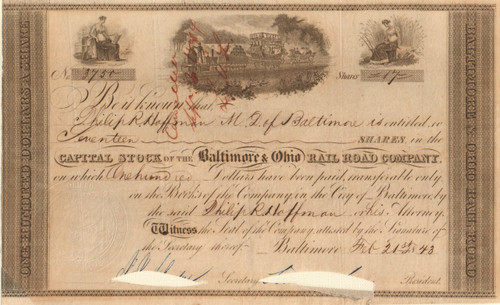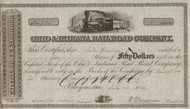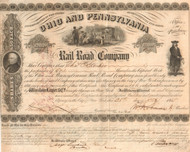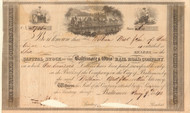Categories
Categories
- Home
- Railroad
- 1800's Railroads
- Baltimore & Ohio Rail Road Company 1843 (early US railroad)
Baltimore & Ohio Rail Road Company 1843 (early US railroad)
Product Description
Baltimore & Ohio Rail Road stock certificate 1843
Uncommon 1840's railroad piece with a great vignette of a Tom Thumb steam train and classical female figures to the right and left. Issued and cancelled (signature cut outs). Dated 1843.
The Baltimore and Ohio Railroad, based in Baltimore, Maryland, was one of the two or three oldest, largest, most important railroads in the history of the mid-Atlantic region. Its great rival was the Pennsylvania Railroad. The B&O was the first Class I railroad in the U.S. as well as one of the first in the nation. During its peak years, the railroad carried coal, steel, and other freight, as well as passengers, as far North as New York City, and as far west as Chicago. Most surviving trackage is operated by CSX Transportation. The B&O provided critical logistic support to the Union during the Civil War, when it was the target of repeated Confederate raids.
The Baltimore & Ohio Railroad (B&O) was not the first railroad in the U.S., but it was the first common carrier railroad and the first to offer scheduled freight and passenger service to the public. It was the first intercity railroad in the United States. The most important American East Coast seaports in the early 1800s were Boston, New York City, Philadelphia, Baltimore, and Charleston, South Carolina. Baltimore had an advantage in being farther inland than the others (and therefore closer to many markets), being located almost at the head of navigation on Chesapeake Bay, the estuary of the Susquehanna River. New York gained an advantage in 1825 with the opening of the Erie Canal, permitting navigation as far as Lake Erie, and in 1826 the Commonwealth of Pennsylvania chartered a system of canals to link Philadelphia with the Ohio River at Pittsburgh.
The fast-growing port city of Baltimore, Maryland faced economic stagnation unless it opened routes to the western states, as New York had done with the Erie Canal in 1820. In 1827, twenty-five merchants and bankers studied the best means of restoring "that portion of the Western trade which has recently been diverted from it by the introduction of steam navigation." Their answer was to build a railroad—one of the first commercial lines in the world. Their plans worked well, as the railroad grew from a capital of $3 million in 1827 to a large enterprise generating $2.7 million of annual profit on its 380 miles of track in 1854, with 19 million passenger miles. The railroad fed tens of millions of dollars of shipments to and from Baltimore and its growing hinterland, thus making the city the commercial and financial capital of the region south of Philadelphia. The B&O planned to build a railroad from Baltimore to a suitable point on the Ohio River.
A route was laid out to follow the upper Patapsco and Monocacy rivers to the Potomac, and work began. The line was opened for scheduled service on May 24, 1830. The first vehicles to run on the railroad were horse-drawn coaches and wagons, but the railroad adopted steam power after the "Tom Thumb" was demonstrated on its track in August 1830. On December 1, 1831, the road was opened to Frederick, 60 miles. The B&O opened a branch from Relay Junction, Maryland (then also called Washington Junction) to Washington in August 1835, crossing the upper Patapsco River above Elkridge, Maryland on the curving, multi-spanned stone Thomas Viaduct, one of the B&O's and American railroading signature structures for 190 years. Two years later a wooden and iron-beamed bridge was completed across the Potomac to Harpers Ferry, West Virginia (then part of Virginia; the separation of the western portion of Virginia did not occur until 1863). At Harpers Ferry the B&O connected with the Winchester & Potomac Railroad, thus forming the first junction of two railroad companies in the U.S. The line continued west through Cumberland, Maryland to Grafton, West Virginia, where it turned northwest to reach the goal of its charter at Wheeling, West Virginia, 379 miles from Baltimore, on January 1, 1853, almost 25 years after commencing construction. Another line was pushed west from Grafton to reach the Ohio River at Parkersburg, West Virginia in 1856. The shipment of coal from the Appalachian fields fueled the B&O's rapid growth.
The B&O was the target of repeated Confederate attacks during the American Civil War. Union forces often failed to properly secure the region, despite the vital importance of the railroad in providing supplies and troops to the battlefronts. Confederate general "Stonewall" Jackson made the Railroad his favorite target. Nevertheless, under the leadership of president John W. Garrett the B&O increased its operations, and increased its profits during the war.
The B&O played a part in the Battle of Monocacy. Agents of the railroad began reporting Confederate troop movements 11 days before the battle, and Garrett had their intelligence passed to authorities in the War Department and to Major General Lew Wallace, who commanded the department that would be responsible for defense of the area. Though Union forces lost the battle, it allowed Union forces to repel the Confederate attack on Washington at the Battle of Fort Stevens two days later. After the battle, Lincoln paid tribute to Garrett, saying "The right arm of the Federal Government, in the aid he rendered the authorities in preventing the Confederates from seizing Washington; securing its retention as the Capital of the Loyal States.
After the end of the war, B&O continued westward in 1866 by leasing the Central Ohio Railroad, a line from Bellaire, Ohio, across the Ohio River from Wheeling, through Newark to Columbus, and in 1869 by leasing a line from Newark to Sandusky, Ohio. From a point on that line called Chicago Junction (now Willard) a subsidiary company, the Baltimore & Ohio & Chicago, built west to Chicago between 1872 and 1874, Opening a major link to the Midwestern agricultural lands.
Under Garrett's leadership, the B&O expanded in several directions at once. In 1871 the Pittsburgh & Connellsville Railroad completed a Cumberland-Pittsburgh line and leased it to the B&O the following year. The Metropolitan Branch, from Washington to a connection with the main line at Point of Rocks, Maryland, was opened in 1873.
As a result of the Panic of 1873, a great national depression, the B&O cut wages. After a second reduction in wages was announced in the same year, workers began the Great Railroad Strike of 1877, on July 14, in Martinsburg, West Virginia. The strike spread to Cumberland, and when the governor of Maryland, on July 20, attempted to put down the strike by sending the state militia from Baltimore, riots broke out resulting in 11 deaths, the burning of parts of Camden station, and damage to several engines and cars. The next day workers in Pittsburgh staged a sympathy strike that was also met with an assault by the state militia; Pittsburgh then erupted into widespread rioting. The strike ended after federal troops and state militias restored order.
The line into Pittsburgh put B&O into Pennsylvania Railroad (PRR) territory, and even in 1871, the PRR was something of a bully. Washington-New York passenger service in the 1870s was operated jointly by the B&O between Philadelphia and Jersey City. In 1872, the PRR built a line of its own from Baltimore to Washington. B&O rerouted its trains off the PRR to the Reading Railroad /Central Railroad of New Jersey route between Philadelphia and Jersey City and proposed to construct terminal facilities of its own on Staten Island - in 1884 B&O purchased the Staten Island Ferry and the Staten Island Railway from Cornelius Vanderbilt which gave the railroad waterfront property on the New York Bay with prospects of further rail connections to Brooklyn or Long Island.
Both B&O and PRR wanted control of the Philadelphia, Wilmington & Baltimore Railroad (PW&B) — PRR managed to get it in 1881. B&O set out to build its own line — the Philadelphia Subdivision — from Baltimore to Philadelphia, parallel to the PW&B and no more than a few miles from it. PRR responded in 1884 by refusing to handle B&O trains east of Baltimore. B&O opened its new line to Philadelphia in 1886.
Garrett died in 1884 and was succeeded by his son Robert for two years, Samuel Spencer for one, and then Charles F. Mayer. Mayer undertook to improve the railroad and at the same time, keep its financial situation from crumbling. The most significant improvements were control of the Pittsburgh & Western Railroad (Pittsburgh-Akron), construction of a line from Akron, Ohio, to Chicago Junction; control of a route from Parkersburg, West Virginia, through Cincinnati to St. Louis (the Baltimore & Ohio Southwestern, which included the former Ohio & Mississippi Railway, completed in 1857); construction of a line through, around, and under Baltimore to connect the Philadelphia route with the rest of the B&O; and electrification of the Baltimore Belt, the first mainline electrification in North America.
The financial situation was more difficult. The B&O had a large debt. Freight and passenger rates were low and revenues were dropping — in 1889 B&O handled 31 percent of the country's tidewater soft coal traffic; in 1896, that had dropped to just 4 percent because of competition from other railroads. The B&O cut back on expenditures for maintenance and quickly acquired a reputation for unreliability. The Panic of 1893 was well underway, and business was in bad shape nationwide. B&O entered receivership in 1896.
B&O came out of receivership in 1899 still under its original charter, which included tax exemption privileges. In 1901 the Pennsylvania railroad bought a large block of B&O stock and appoint Leonor F. Loree its president. Loree undertook a line improvement program that reduced grades and curves and added many miles of double track, and he secured for B&O a large interest in the RDG, which in turn controlled the CNJ. The PRR sold some of its B&O stock to the Union Pacific Railroad (UP) in 1906 and traded the remainder to UP for the Southern Pacific stock in 1913. UP eventually distributed its B&O stock as a dividend to its own stockholders. Oscar G. Murray was president of the B&O when the majestic B&O Railroad Headquarters Building was completed in 1906. The previous structure burnt down in the Great Baltimore Fire of 1904.
Daniel Willard became president of the B&O in 1910. More than anyone else he is responsible for the company's conservative, courteous personality in the mid-twentieth century. Further expansion included the purchase in 1910 of the Chicago Terminal Transfer Railroad, a belt line that was renamed the Baltimore & Ohio Chicago Terminal Railroad; the acquisition in 1917 of the Coal & Coke Railway from Elkins to Charleston, West Virginia; and acquisition that same year of portions of the Cincinnati, Hamilton & Dayton Railway and its leased lines to form a route from Cincinnati to Toledo.
In 1927 B&O celebrated its centennial with the Fair of the Iron Horse, a pageant and exhibition at Halethorpe, Maryland. Much of the rolling stock exhibited there was from B&O's museum collection, which formed the nucleus of the B&O Railroad Museum in Baltimore, one of the earliest railroad museums.
The Interstate Commerce Commission (ICC) merger plan of the 1920s put B&O into an expansionist mood. In 1926 B&O purchased the Cincinnati, Indianapolis & Western Railroad's line from Hamilton, Ohio to Springfield, Illinois. In 1927 it acquired an 18 percent interest in the Wheeling & Lake Erie Railway (W&LE) and began to purchase Western Maryland Railway (WM) stock. In 1929 B&O bought the Chicago & Alton, reorganized it as the Alton Railroad, and operated it as part of the B&O. (Alton regained independence in 1943 and merged with the Gulf, Mobile & Ohio Railroad in 1947.) In 1932 B&O acquired the Buffalo, Rochester & Pittsburgh Railway from the Van Sweringen brothers in exchange for its interest in the W&LE and also purchased the Buffalo & Susquehanna Railroad. In 1934 B&O arranged for trackage rights on the Pittsburgh & Lake Erie Railroad's (P&LE) water-level route between McKeesport and New Castle, Pennsylvania, bypassing the curves and grades of its own route (which remained in service for local business). B&O's through passenger trains moved to P&LE's Pittsburgh station across the Monongahela River from the B&O station. In the first half of the twentieth century the B&O ran commuter rail operations out of Baltimore, Pittsburgh and Washington, D.C.
For many years the B&O competed with the PRR and New York Central Railroad (NYC) in the New York-Chicago and New York-St. Louis passenger markets and with PRR on the New York-Washington run. B&O's trains were slower, partly because of their longer route through Washington, but they were dieselized a decade before the competition. Many preferred B&O's New York-Washington trains to PRR's, but the most frequently stated reason for preferring B&O — "You could always get a seat" — was the reason B&O dropped its passenger service east of Baltimore in April 1958. Also, PRR had the advantage of running trains directly into New York City's Manhattan Island. The B&O trains terminated in the Central Railroad of New Jersey Terminal in Jersey City, requiring passengers to take a ferry across the Hudson River. The B&O operated a special bus service by which buses picked up passengers in Manhattan and drove passengers directly onto the ferry.
In 1960 the Chesapeake & Ohio Railway (C&O) began to acquire B&O stock. NYC made a bid, but B&O's stockholders approved C&O control, and on May 1, 1962, so did the ICC. By early 1964 C&O owned 90% of B&O's stock. In 1967 the ICC authorized C&O and B&O to control WM; B&O's WM stock had long been held in a nonvoting trust. On June 15, 1973, B&O, C&O, and WM were made subsidiaries of the newly created Chessie System, although they continued to operate as separate railroads. There was no great surge of track abandonment, because in most areas B&O and C&O were complementary rather than competitive. In 1981 B&O leased the former Rock Island trackage from Blue Island to Henry, Illinois.
B&O continued to exist with the Chessie System. On May 1, 1983, B&O assumed operations of the WM. Four years later, on April 30, 1987, C&O merged B&O, and four months after that, CSX Transportation merged C&O
 Loading... Please wait...
Loading... Please wait... 









